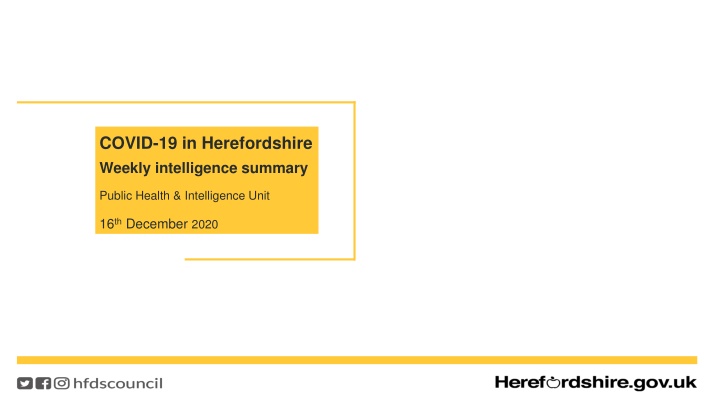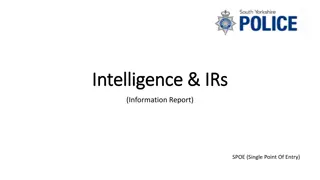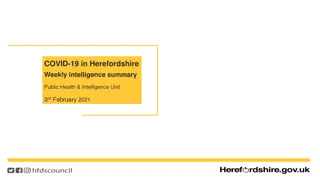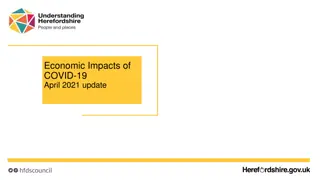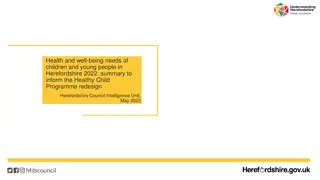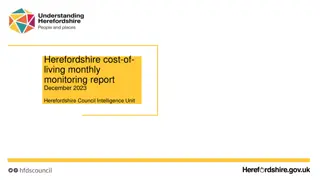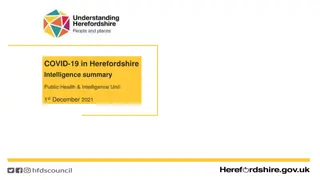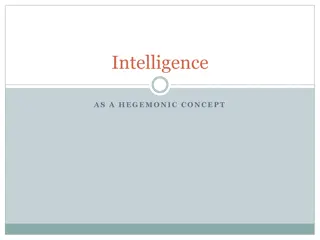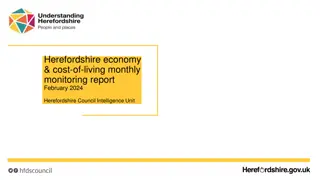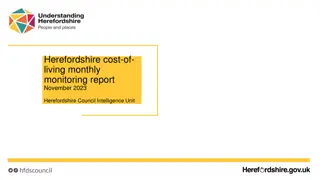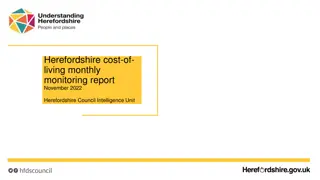COVID-19 Update in Herefordshire: Weekly Intelligence Summary (16th December 2020)
Herefordshire is moving to Tier 1 with caution urged for Christmas bubbles. Testing demand has decreased. New cases have fallen but could be rising. Total cases now at 2,700. Rates per 100,000 population are improving. Concern for vulnerable age groups persists. More deaths reported. Analysis shows non-COVID causes of death remain prevalent. Unemployment claims steady since May.
Download Presentation

Please find below an Image/Link to download the presentation.
The content on the website is provided AS IS for your information and personal use only. It may not be sold, licensed, or shared on other websites without obtaining consent from the author.If you encounter any issues during the download, it is possible that the publisher has removed the file from their server.
You are allowed to download the files provided on this website for personal or commercial use, subject to the condition that they are used lawfully. All files are the property of their respective owners.
The content on the website is provided AS IS for your information and personal use only. It may not be sold, licensed, or shared on other websites without obtaining consent from the author.
E N D
Presentation Transcript
COVID-19 in Herefordshire Weekly intelligence summary Public Health & Intelligence Unit 16th December 2020
Contents 1. 2. 3. 4. 5. 6. 7. 8. Key messages (slide 3) COVID-19 testing (slide 4) COVID-19 cases (slides 5-7), including demographics (slide 8-9) and local areas (slides 10-11) Profile of deaths: published data (slides 12-13) Wider impacts new national restrictions (slide 14) Effects of lockdown on population movement (slide 15) Wider impacts the economy (slide 16) Other resources (slide 17) Please note that the next full summary will be published on the 8th January If you need help to understand this document, or would like it in another format or language, please contact us on 01432 261944 or e-mail researchteam@herefordshire.gov.uk
Key messages This week s update is finalised as the government announced that Herefordshire will move down into the lowest alert level: Tier 1 medium on Saturday 19 December. Christmas bubbles of up to 3 households can be formed between 23 and 27 December, but caution is being urged. After peaking at 900 tests a week in the middle of November, demand for tests from symptomatic residents has fallen back to October levels (~600). Daily numbers of new cases in Herefordshire have fallen for the third week running and are now back to the levels seen in early October. There are however early indications that rates are beginning to rise again, as is being seen in neighbouring areas and nationally. The total number of lab-confirmed cases throughout the course of the pandemic is now 2,700 (16 December). This is 86 more than for the same time last week. This increase is similar to that seen in the previous week (85) and is similar to the number recorded in the first week of October. The latest 7-day rate per 100,000 population is 46 (10 Dec), having peaked at 192 on 14-15 November. It is the lowest since mid-October, but may start to rise as the latest cases come through. There are currently no particular geographic hotspots . The highest rates per 100,000 population are still being seen amongst 18-21 year-olds. Although the rate amongst people aged 80+ has fallen in the last week this group and those aged 70-79 (the rate for which rose this week) continue to give a cause for concern as these groups are particularly vulnerable. Seven further deaths of Herefordshire residents involving COVID-19 were included in the latest published ONS data (occurring by 4 Dec and registered by 12 Dec), five of which had occurred in this week. This takes the total to 152 over the course of the pandemic. PHE data suggests that a further four have occurred since 4 Dec, and will appear in future weeks official counts. Overall deaths remain around average for the time of year Analysis of all causes of death in Herefordshire between March and October has shown that, despite Covid-19, the two most common causes of death have still been dementia/Alzheimer disease and heart disease. Covid-19 was the third most common cause, accounting for 16% of all deaths. Deaths from 'flu / pneumonia and cerebrovascular disease (e.g. stroke) have been notably lower than normal since March. The number of people claiming unemployment benefits has remained fairly steady since May more than double the level in March. In November, 4,700 people were claiming, almost 900 of whom were aged 18-24.
COVID-19testing The graph gives a complete picture of local PCR testing for Herefordshire: all tested residents, regardless of where the test was carried out; all care home testing; and testing of patients and staff by Wye Valley Trust. These are the only tests which can lead to a lab- confirmed case. Testing rates have been rising since late July, reflecting the national drive to increase capacity. Numbers rose sharply during early November - reaching 5,800 in the week ending 20 Nov. Numbers fell just as sharply back to October levels (~4,400) by the end of the month. As capacity hasn t changed, and the drop in tests coincided with declining case rates this is likely to reflect changes in demand from symptomatic residents. The additional mobile testing units (MTUs) which have been in Leominster and South Hereford for the last few weeks are currently providing around 46 and 41 tests a day respectively (down from 60 for both sites during the peak in November). Lateral flow testing (LFT) is now being rolled out amongst health staff. These non lab-based tests provide a much quicker result for people showing no symptoms, although a positive result still requires a PCR test before becoming a lab-confirmed case. By 13 Dec, 707 have been carried out in Herefordshire and processed by commercial labs (Pillar 2). Data is not yet available for NHS/PHE labs (Pillar 1) These tests are not included in the chart opposite. Where can I find out more? Local level testing data isn t published, but see details of national reporting at www.gov.uk/guidance/coronavirus-covid-19-information- for-the-public. Details of the roll-out of lateral flow tests to local authorities was published by the government on 9 November.
Lab-confirmed COVID-19 cases in Herefordshire Lab-confirmed cases are the official count of people who live in Herefordshire and have tested positive for COVID-19. Numbers of confirmed cases are linked to the availability of testing, so the cases chart highlights key dates in testing policy. The total lab-confirmed cases over the course of the epidemic is now 2,700 (15 Dec). This is 86 more than this time last week, all from swabs taken between 9 and 15 December (note that reporting lags mean daily numbers can change). This increase is similar to that seen in the previous week (88) and to increases reported in early October. The line on the chart shows the average number of new cases each day. After peaking at 53 on 12 November (10 days into lockdown), it has fallen sharply in recent weeks back to the levels seen in mid-October (10-15 new cases a day). The latest few days complete data indicate an upturn since the end of lockdown, which would mirror the national pattern. So far, however, it has only been a small increase: 15 new cases per day as at 9 December. Where can I find out more? Confirmed cases are updated daily by PHE at https://coronavirus.data.gov.uk/. These are used in tools such as the LG Inform Tracker.
Lab-confirmed cases: comparisons The chart shows the recent trend in cases per 100,000 resident population for 7-day periods (the latest one ending 5 days ago to allow for lags in the results of tests). This rate is now commonly quoted in national reporting, often in relation to whether an area should move between the different local Alert levels (tiers) Herefordshire's weekly rate rose sharply in the first two weeks of November, reaching a peak of 192 per 100,000 on 15 Nov ten days into the English lockdown. In line with national and regional patterns, it has fallen just as sharply since then. However, while the national and regional figures have risen over the last week the local rate has continued to fall, although less steeply than previously. At 46 per 100,000 (10 Dec) the rate is at its lowest since 16 Oct, and is approximately a quarter of both English and West Midlands rates. Rates are rising elsewhere in England, most sharply in London, the South-East and East. Northern regions, which were subject to the highest restrictions before the national lockdown, haven t seen such rises so far. The sharp rise seen in Wales in the last few weeks following the end of their firebreak lockdown seems to have peaked last week. ! Be aware ! - Rates per 100,000 resident population give a fairer comparison of the number of cases in each area but they do not take account of the different rates of testing or differences in the age and sex of the local populations. - With one of the smallest upper tier local authority populations (193,200), Herefordshire s rate can be dramatically affected by relatively small changes in numbers of cases. An average of 28 cases a day in a week would result in a rate of 100 per 100,000. - These are not rates of infection amongst the population: they can only reflect those who have been tested, so numbers are highly dependent on the availability of tests. Where can I find out more? The graph is based on daily updated PHE data on lab-confirmed cases. Further comparisons are included in theLG Inform dashboard. You can also view the local 7-day case rates and numbers on the Herefordshire Council website.
Lab-confirmed cases: comparison with neighbouring authorities Telford & Wrekin 133 per 100,000 239 cases Latest published comparisons, for the week ending 11 December*, show: Herefordshire s rate is currently half the rate in Shropshire, and much lower than all its other neighbours Last week, 7-day case rates were rising in Welsh neighbours but continued to fall in English ones. This week, all surrounding areas have seen an increase (as indicated by the up/down arrows). Although Herefordshire s rate fell in the last week, it was quite a small reduction from 57 per 100,000 in the week ending 4 Dec, to 51 by the 11 Dec. Shropshire 97 per 100,000 312 cases Worcestershire 115 per 100,000 685 cases Powys 120 per 100,000 159 cases Herefordshire 51 per 100,000 98 cases Gloucestershire 135 per 100,000 861 cases Monmouthshire 285 per 100,000 270 cases * Note that he slight lag in this data reflects the latest date for which complete data is available from test results Time period: (5/12/20 to 11/12/20) Where can I find out more? Maps comparing 7 day numbers of cases and rates per 100,000 people are updated daily by PHE at https://coronavirus.data.gov.uk/.
Demographics of COVID-19 cases in Herefordshire: age profile Lab-confirmed cases each week by age Number 400 These charts show the age profile of lab-confirmed cases for each week since March: the top one shows absolute numbers of cases and the bottom one shows age-groups as a percentage of all cases that week September and October saw a much younger profile of lab- confirmed cases than in the first wave in April and May, but increasing proportions of older people tested positive during November s spike in cases Whilst increased numbers have been seen in all age groups since early October, cases amongst older people are of particular concern as they are more likely to become acutely unwell and require hospitalisation. 300 200 100 0 Proportion % 100 80 % aged: 18-30 65+ All cases 60 First wave: April / May testing limited to suspected cases most at risk of serious illness September / October rising numbers of cases coinciding with return of schools and universities and general relaxing of restrictions. Rule of 6 implemented. November/December Highest numbers of confirmed cases to date 40 14% 37% 653 20 31% 16% 586 0 1 8 7 6 6 3 5 3 4 2 9 4 13 20 27 24 12 19 26 24 31 11 18 25 23 30 11 10 17 15 22 29 10 17 14 21 28 16 13 20 27 March April May June July August Sept Oct Nov Dec Week Ending 19% 21% 1,183 1: <18 2: 18-30 3: 31-64 4: >64
Demographics of COVID-19: rates per 100,000 by age over time This heat map shows how the 7-day rates per 100,000 for specific age groups have changed each week from July. Each row represents an age group. As rates increase, the chart colours become darker. It is important to note that rates per 100,000 can be significantly affected by relatively small numbers of cases in a population as small as Herefordshire, even more so when broken down into age-groups. The absolute number of cases are shown as context. The farm outbreak stands out in July, when rates were otherwise low for all ages for most of the summer. From the end of September to mid- November rates increased in all age groups, most notably in 18 to 21 year-olds: 9% of all cases despite only making up 3% of the population. Rates have fallen in all ages since the middle of November, although in the week to 11 Dec small increases were seen in a number of age groups, particularly in those aged 18 to 29. The highest rate is still amongst 18-21s. Number of cases this week 7 10 6 2 22 12 20 13 2 3 1 people in age group 12,900 21,900 26,100 28,800 22,100 22,100 16,200 6,600 14,100 12,900 9,100 The rate amongst people aged 80+ has halved in the last week while the figure rose for 70-79s. High rates in these age groups are a cause for concern as they are particularly vulnerable. Weekly rates per 100,000 population 0 0 0 0 0 0 0 5 4 4 0 0 3 17 24 3 0 77 72 9 5 68 41 9 0 179 62 12 0 61 76 46 0 0 0 0 0 0 0 0 0 0 0 0 0 0 4 7 9 14 18 0 0 0 0 15 5 8 0 5 0 0 0 0 8 0 0 0 0 3 0 14 6 0 0 0 11 8 0 12 0 9 5 37 15 0 0 0 0 0 0 3 9 0 0 0 0 0 0 8 0 0 3 5 23 25 15 0 0 0 39 0 15 35 18 23 43 107 7 0 11 0 0 12 7 18 9 6 76 21 0 0 15 9 8 3 14 0 25 31 0 0 11 15 14 12 17 5 5 12 76 0 0 0 15 9 42 24 9 50 62 259 0 0 33 23 23 35 49 27 18 92 290 43 23 44 85 59 58 101 77 77 74 275 78 31 99 62 46 69 101 163 86 123 153 71 0 33 131 73 73 118 131 104 117 214 114 16 22 170 128 176 229 203 249 265 290 71 78 44 186 109 115 177 145 127 215 198 135 86 110 101 59 65 14 117 63 129 229 43 39 33 101 27 27 10 77 104 80 183 28 70 22 54 46 23 7 99 54 123 198 14 23 11 80+ 70-79 60-69 50-59 40-49 30-39 22-29 18-21 11-17 5-10 Age <5 2 37 24 6 6 4 3 7 2 7 23 10 9 11 34 46 81 85 99 180 144 71 57 51 All ages Total number of weekly cases 3 71 47 11 11 7 6 14 3 13 44 20 17 22 65 88 156 163 191 348 277 137 109 98 3 10 17 July 24 31 7 14 August 21 28 4 11 18 25 2 9 16 23 30 6 13 20 27 4 11 September October November Dec Week Ending Time
Lab-confirmed cases around the county: this week Positive cases from samples taken in the 7 day period ending 11/12/20* The map shows the latest 7-day rates of new cases per 100,000 population, as published by Public Health England: the darker the shading, the higher the rate (unshaded areas have had fewer than 3 cases in the last 7 days). - It s important to note that these rates are very sensitive to small changes for small areas like MSOAs^. For instance, an increase of 1 case from 9 to 10 cases in an area of 10,000 people (about the size of Ledbury), would increase the rate from 90 to 100 per 100,000. Note that data for Wales is not included Reflecting the general fall in cases, eight of Herefordshire s 23 MSOAs^ had fewer than 3 cases in the week to 11 December* The highest area in terms of both numbers and rates were in Hereford Central (11 cases, 109 per 100,000) this is the only area with a rate higher than 100 cases per 100,000 population.. However, in the last week all Herefordshire MSOAs returned rates below the national average. * Note that the slight time-lag in this data reflects that test results are incomplete for the most recent few days ^ Middle super output areas: geographies designed by the Office for National Statistics in 2004 to have broadly similar population sizes which means that they tend to be geographically bigger in rural Herefordshire. Data supressed where numbers are low to avoid possible identification of individuals Where can I find out more? This map of weekly confirmed cases by middle super output area (MSOA) in England are included in the PHE dashboard, which is updated daily.
Lab-confirmed cases around the county: trends in rates over time Whilst the previous slide shows cases in the last 7 days, this heat map shows how the 7-day rates per 100,000 have changed in each area of Herefordshire from August. The areas (MSOAs*) are ranked by the rate in the last week with the highest at the top. The heat map shows clearly how cases had generally been scattered across the county and were relatively low in all areas until mid-October Whilst all areas saw a rise in early November, there were notable hotspots in South Hereford, the rest of the city and a few neighbouring areas The last three weeks ending Dec 11 indicated that rates have generally returned to mid-October levels across the majority of the county although marginal increases have been seen in a number of areas over the last week. In the two weeks to Dec 4 the rate for South Leominster had been more than 3 times the county figure. Many of these cases were linked to a known outbreak, and the rate has now returned to a similar level to other areas. Number of Cases this week 11 8 9 6 4 5 7 7 4 5 6 5 4 3 2 2 3 2 2 2 1 0 0 MSOA Population 10,100 8,200 9,800 6,900 6,000 7,700 11,300 11,300 6,500 8,300 10,800 9,300 7,800 6,200 6,100 6,300 10,100 6,800 8,900 12,100 7,200 9,600 5,800 Weekly rates per 100,000 population 0 0 10 0 0 0 12 0 10 0 10 10 0 0 0 0 17 0 0 0 13 0 0 0 0 0 18 0 18 0 9 0 0 0 0 0 0 0 0 0 9 9 9 0 0 11 11 0 0 0 26 0 0 0 0 0 0 0 16 0 0 0 16 0 0 0 0 10 0 0 0 15 11 11 0 0 0 25 17 0 0 0 0 0 0 0 0 0 0 0 0 0 MSOA Hereford Central 0 0 0 20 36 10 44 17 39 9 0 0 12 37 22 77 0 49 95 20 30 11 0 0 31 0 0 20 12 10 0 17 26 0 0 0 12 9 0 0 48 16 0 10 0 0 0 0 0 51 10 0 0 15 0 13 18 18 31 0 9 32 0 0 33 16 30 0 11 0 0 10 17 70 24 31 58 33 39 9 71 93 0 9 22 39 64 16 16 10 15 22 41 28 42 34 50 12 31 58 100 13 80 62 0 0 65 32 65 32 0 64 50 44 11 108 42 21 69 89 49 72 102 100 91 62 141 15 73 74 32 168 128 16 95 80 89 78 116 42 31 103 99 49 133 58 50 91 98 71 93 97 93 151 129 64 33 0 90 118 45 83 84 42 137 89 243 194 29 134 78 53 44 124 242 56 118 116 64 66 64 80 118 157 83 84 31 17 288 146 542 117 351 156 169 53 108 399 93 237 129 48 98 159 50 236 67 133 237 177 172 159 194 399 117 184 104 169 62 31 435 65 151 129 48 82 111 30 162 123 91 98 229 69 40 49 164 58 67 117 35 62 15 85 28 118 65 0 98 254 10 118 45 83 56 83 17 79 49 82 87 83 78 35 18 46 48 28 75 77 0 66 270 10 0 34 66 84 21 34 109 97 92 87 67 65 62 62 62 60 56 54 52 48 33 32 30 30 22 17 14 0 0 Kington Eardisley & Staunton Hereford South Fownhope, Tarrington & Marcle 12 10 44 0 13 0 9 0 24 19 32 13 0 16 16 0 0 0 17 0 10 0 15 0 0 9 0 0 0 28 0 13 0 0 16 0 15 0 17 0 31 0 Hereford East Lugwardine, Withington and Moreton on Lugg Kingstone & Kingsthorne Ross-on-Wye Wigmore, Orleton and Brimfield Hereford South West Bromyard & Bishop's Frome Hereford North West Hereford North East Golden Valley North Leominster South Leominster Ledbury Belmont, Madley & Clehonger Shobdon, Luston & Bodenham Penyard, Llangarron & Goodrich Hereford West Credenhill, Weobley & Wellington Colwall, Cradley & Wellington Heath Herefordshire 4 3 7 2 7 23 10 9 11 34 46 81 85 99 180 143 72 57 51 Total weekly cases 7 6 14 3 13 44 20 17 22 65 88 156 163 191 348 276 138 109 98 7 14 21 28 4 11 September 18 25 2 9 16 23 30 7 14 21 28 4 11 * Middle super output areas: geographies designed by the Office for National Statistics in 2004 to have broadly similar population sizes August October November Dec Week Ending Time
Profile of deaths: published data Seven further deaths where COVID-19 was mentioned on the death certificate were included in this week s published ONS data (occurring by 4 Dec and registered by 12 Dec) five of these deaths occurred in the week ending 4 Dec while two were delayed registrations. This takes the total amongst Herefordshire residents to 152. Numbers of COVID related deaths have increased during late autumn and early winter: 19 in the seven weeks for which data has been published since the third week of October, compared to nine in the previous 19 weeks. Fourteen were in hospital, and four in care homes. Despite this, the overall number of deaths remain around average levels for the time of year (between 40 and 50 a week) whereas nationally and regionally excess deaths have increased in recent weeks. Of the 152: 69 have occurred in care homes, 75 in hospital (some of whom will have been care home residents), 5 at home and 3 in a hospice. Public Health England are now publishing daily numbers of people who have died within 28 days of a first positive test for Covid-19: 124 in total, a figure lower than that published by ONS as the latter does not require a positive test for COVID to be mentioned on a death certificate Four of these deaths have been registered since 4 Dec - these are likely to be counted in next week s ONS death registration data. Where can I find out more? ONS publish provisional data on weekly numbers of registered deaths by usual residence for local authorities every Tuesday, with an 11 day lag. Deaths recorded as COVID- 19 by ONS include deaths where possible or confirmed COVID-19 is mentioned as any cause of death. They are therefore higher than the PHE figures, which only include those who have died following a positive test.
Profile of deaths: main causes of death This chart compares the top ten causes of death in Herefordshire since the first Covid-related death was recorded with the normal pattern over the same months (March to October) Despite Covid, the top two causes of death have still been dementia / Alzheimer disease and heart disease Covid-19 has been the third biggest cause of death in Herefordshire since March 2020 (accounting for 16%), and appears to have been the underlying factor in a fall in mortality rates for most other causes Notable drops have been seen in mortality from flu / pneumonia and cerebrovascular disease (e.g. stroke) Where can I find out more? This analysis is based on the restricted access Primary Care Mortality Database, the Office for National Statistics official dataset on mortality. See their monthly analysis of national trends at: www.ons.gov.uk/peoplepopulationandcommunity/birthsdeathsandmarriages/deaths/bulletins/monthlymortalityanalysisenglandandwales/october2020
Wider impacts: clinically vulnerable people National lockdown restrictions were in place in England from 5 November for four weeks. They were replaced on 2 December by a strengthened system of local tiers. From 19 December, Herefordshire will move from Tier 2 to the lower alert level of Tier 1. Christmas bubbles will be permitted between 23 and 27 December, but the government has urged people to think carefully about the risks and minimise contact. Everyone: Hands - Face Space. Follow the rules on meeting others safely; work from home; walk or cycle. No-one has been advised to shield since the end of July, but those who are CEV are advised to be particularly vigilant and minimise the number of people they come into contact with 193,200 Herefordshire residents Clinically Vulnerable: be especially careful & minimise contact with others Local and national support systems were re-introduced for the 4-week November lockdown CEV people needing support were encouraged to register with the government s National Shielding Support Service (NSSS) In total, 390 registered in Herefordshire, with the majority (220) wanting priority online delivery slots 70 requested contact from the council, and of the 50 who were able to be contacted, 15 needed support for either food or other reasons 56,000 residents(1 in 3) 70+; eligible for annual flu jab on medical grounds; pregnant Clinically Extremely Vulnerable 7,200 (4%) * People aged 60+ have also been identified as potentially being at higher risk. 26,100 residents are aged 60-69 Specific serious health conditions
Effects of lockdown on population movement This chart shows average visits to different categories of places, using location data of Google users, compared to the beginning of 2020. Visits to all categories except residential fell in November during the English national restrictions ( Lockdown 2.0 ), but not to the levels seen at the end of March. Unsurprisingly, retail and recreation places like restaurants, caf s, shopping centres, museums, libraries and cinemas which had to close saw the sharpest drop. However, there was a noticeable upturn at the end of the second lockdown - although it is still (as of 11 Dec) 21% below the baseline. Only visits to parks exceeded their baseline level after the full lockdown, but this may be a seasonal effect (comparable data for last summer is not available). The other categories saw gradual increases, but never returned to their baseline levels and are yet to show any impact of the end of lockdown 2.0. Changing visits in Herefordshire to Updated English lockdown 2.0 (5 Nov) Full national lockdown (23 Mar) Residential Grocery & pharmacy Parks Retail & recreation Stations Workplaces English lockdown 2.0 ends (2 Dec) Where can I find out more? This chart is updated daily on the Data Orchard website, using data published by Google at www.google.com/covid19/mobility/. The baseline is the median value, for the corresponding day of the week, during the five weeks 3 Jan 6 Feb 2020. Note that the data is based on movements of those who have opted to turn on location history in their Google accounts on their mobile devices.
Wider impacts: the economy Latest data on the impact on Herefordshire s workforce was published this week: 4,700 people aged 16+ claiming unemployment related benefits in November: Month-by-month comparisons are difficult as previous months data is often revised, but numbers have remained at a similar level since May (4,600 to 5,000); the highest since modern records began 1,700 more claimants than at the peak related to the 2008-09 recession More than double the number in March 2020 (+122%) 865 of them were aged 18-24, a figure which has risen in line with the overall increase locally although fell by 5% in the last month. Both have risen slightly more than the national increase, although started from a much lower base. Take-up of the government's Coronavirus Job Retention Scheme (furlough) and Self-Employment Income Support Scheme: By the end of July, a total of 24,800 (31%) of eligible employments had been furloughed; preliminary data for the end of September indicates that 5,400 employments (7%) were furloughed both similar to nationally By the end of July 9,300 self-employment claims (72% of eligible) had been made. The second grant has been available since mid-August; by the end of October 7,800 claims had been made (59% compared to 69% nationally) 5,000 local businesses had received a small business support grant by the end of September, with payments made totaling 58.6 million - 99% of eligible hereditaments (compared to 94% nationally). A new interactive map from ONS indicates that compared to other areas of the UK in November, Herefordshire had slightly higher than average numbers of businesses currently trading (83%) and lower numbers reporting a fall in turnover (35%), but higher numbers reporting problems with their cash reserves (48%) Where can I find out more? The data is published and analysed on a national level by ONS and HMRC. The Intelligence Unit produce a monthly economic monitor, currently available on request.
Other resources Wider vulnerabilities A factsheet of the numbers of people in Herefordshire likely to be affected by different aspects of the virus and the measures taken to control its spread can be downloaded from the Understanding Herefordshire website (produced March 2020) A monthly monitor of key economic recovery indicators: contact the intelligence unit New research and open access analytical tools are continually emerging. As well as the sources linked to throughout these slides, you may be interested in: The Office for National Statistics' daily coronavirus roundup: the latest research into the effects on the economy and society The Health Foundation - COVID-19 policy tracker: an interactive timeline of key events and government policy announcements related to coronavirus An LG Inform dashboard tailored to Herefordshire & Worcestershire, showing daily updates in cases and comparisons with other areas. A Herefordshire Council dashboard provides up to date information on cases in the county and provides links to other useful information.
